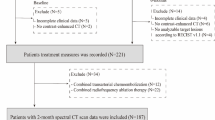Abstract
Purpose
This study aimed to predict the treatment response for colorectal liver metastases (CLM) using relative tumor enhancement (RTE) of the hepatobiliary phase (HBP) for patients with no history of chemotherapy.
Materials and methods
In this retrospective study, we enrolled 26 patients [14 males, 12 females; median age: 58 years (range 37–82 years)] with CLM and no history of chemotherapy between December 2011 and May 2017. Gadoxetic acid-enhanced magnetic resonance imaging was performed before starting chemotherapy and RTE of HBP. The response was evaluated using RECIST ver.1.1, and progression-free survival (PFS) was estimated.
Results
Based on the RECIST ver.1.1, there were 15 responders and 11 non-responders. In the tumor, the mean pretreatment RTE values were significantly higher in the responders group than in the non-responders group (37.2% ± 10.9% vs. 17.9% ± 10.5%, respectively; P = 0.0006). When the threshold values of parameters for detecting responders comprised the RTE value of 24.2% (area under the curve value, 0.90), the sensitivity and specificity were 93.3% and 72.7%, respectively. The median follow-up period for 26 patients was 602 days (range 160–1971 days). Although no significant differences were observed in PFS between the groups, the high RTE group tended to take longer to progress than the low RTE group (PFS of the high RTE group did not reach the median).
Conclusion
This study suggests that the RTE value of CLM could be a potential biomarker to predict early treatment response.




Similar content being viewed by others
References
Chen L, Zhang J, Zhang L, et al. (2012) Meta-analysis of gadoxetic acid disodium (Gd-EOB-DTPA)-enhanced magnetic resonance imaging for the detection of liver metastases. PLoS ONE 7(11):e48681
Ringe KI, Husarik DB, Sirlin CB, Merkle EM (2010) Gadoxetate disodium-enhanced MRI of the liver: part 1, protocol optimization and lesionappearance in the noncirrhotic liver. AJR Am J Roentgenol. 195(1):13–28
Lockhart AC, Harris E, Lafleur BJ, et al. (2008) Organic anion transporting polypeptide 1B3 (OATP1B3) is overexpressed in colorectal tumors and is a predictor of clinical outcome. Clin Exp Gastroenterol. 1:1–7 (Epub 2008 Nov 2)
Park SH, Kim H, Kim EK, et al. (2017) Aberrant expression of OATP1B3 in colorectal cancer liver metastases and its clinical implicationon gadoxetic acid-enhanced MRI. Oncotarget. 8(41):71012–71023
Vavricka SR, Jung D, Fried M, et al. (2004) The human organic anion transporting polypeptide 8 (SLCO1B3) gene is transcriptionally repressed by hepatocyte nuclear factor 3β in hepatocellular carcinoma. J Hepatol. 40:212–218
Muto M, Onogawa T, Suzuki T, et al. (2007) Human liver-speci c organic anion transporter-2 is a potent prognostic factor for human breast carcinoma. Cancer Sci. 98:1570–1576
Hamada A, Sissung T, Price DK, et al. (2008) Effect of SLCO1B3 haplotype on testosterone transport and clinical outcome in caucasian patients with androgen- independent prostatic cancer. Clin Cancer Res. 14:3312–3318
Lee W, Belkhiri A, Lockhart AC, et al. (2008) Overexpression of OATP1B3 confers apoptotic resistance in colon cancer. Cancer Res. 68:10315–10323
Eisenhauer EA, Therasse P, Bogaerts J, et al. (2009) New response evaluation criteria in solid tumours: revised RECIST guideline (version 1.1). Eur J Cancer. 45(2):228–247. https://doi.org/10.1016/j.ejca.2008.10.026
Chun YS, Vauthey JN, Boonsirikamchai P, et al. (2009) Association of computed tomography morphologic criteria with pathologic response and survival in patients treated with bevacizumab for colorectal liver metastases. JAMA 2(302):2338–2344. https://doi.org/10.1001/jama.2009.1755
Teft WA, Welch S, Lenehan J, et al. (2015) OATP1B1 and tumour OATP1B3 modulate exposure, toxicity, and survival after irinotecan-based chemotherapy. Br J Cancer. 112(5):857–865 (Epub 2015 Jan 22). https://doi.org/10.1038/bjc.2015.5
Cui Y, Zhang XP, Sun YS, et al. (2008) Apparent diffusion coefficient: potential imaging biomarker for prediction and early detection of response to chemotherapy in hepatic metastases. Radiology 248:894–900. https://doi.org/10.1148/radiol.2483071407
Author information
Authors and Affiliations
Corresponding author
Ethics declarations
Funding
This study was funded by Japan Society for the Promotion of Science (JSPS) KAKENHI (Grant Number JP16K19879).
Conflict of interest
All authors declare relevant conflicts of interest to disclose.
Ethical approval
All procedures performed in studies involving human participants were in accordance with the ethical standards of the institutional and national research committee and with the 1964 Helsinki declaration and its later amendments or comparable ethical standards.
Informed consent
The requirement for informed consent was waived by our Institutional Review Board.
Rights and permissions
About this article
Cite this article
Murata, S., Matsushima, S., Sato, Y. et al. Predicting chemotherapeutic response for colorectal liver metastases using relative tumor enhancement of gadoxetic acid disodium-enhanced magnetic resonance imaging. Abdom Radiol 43, 3301–3306 (2018). https://doi.org/10.1007/s00261-018-1615-z
Published:
Issue Date:
DOI: https://doi.org/10.1007/s00261-018-1615-z




